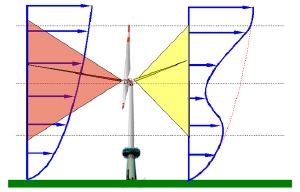Mar 6 2008
Wind energy is currently regarded as the most important source of renewable energy. The optimal operation of the newest generation of large wind turbines is possible through the reliable measurement of the wind inflow characteristics. Experience has shown that the accurate power generation estimation based on wind speed is a challenging task.
 Sketch of measurement of wind characteristics with a remote sensing technique at hub height (Figure: SWE).
Sketch of measurement of wind characteristics with a remote sensing technique at hub height (Figure: SWE).
For large new turbine models, conventional met mast wind speed measurements are not feasible based on cost and technical considerations. Researchers at the Endowed Chair of Wind Energy (SWE) of the University of Stuttgart are working together with researchers from the University of Oldenburg and other project partners on an alternative remote sensing technique. LIDAR technology (Light Detection and Ranging) is being developed and tested for wind energy applications. This laser-based measurement technique performs wind field measurements in a more flexible and economical way. Currently, LIDAR is the best candidate to replace the met mast based wind measurements, used in power curve calculations, for offshore wind farms.
LIDAR systems detect wind speed and direction based on the time delay of the laser beam reflected by airborne aerosols. This technology has been used for decades, mainly for atmospheric research. In the last years the wind energy industry has seen the advantages of this technology for wind field measurements. The present research project aims to further develop LIDAR technology for wind energy applications. The objective is to establish this measurement technique as a quality standard for wind field measurements with the spatial and temporal resolution needed by the wind energy industry.
The research concentrates on two main topics, namely, power curve assessment and wind field measurement from the nacelle. The first deals with ground-based approaches to replace conventional anemometers mounted on a met mast. The second aims at the development and verification of new nacelle-based approaches to measure inflow and wake wind fields. Control strategies and far wake models are also developed and tested with the measurements.
The SWE coordinates a group of partners which are evaluating a commercial LIDAR system supplied by Leosphere®. The research center ForWind at the University of Oldenburg will work on new methods for unsteady power curve estimation. The German Aerospace Center (DLR) brings in experience using LIDARs for atmospheric research and airplane wakes. Power curve measurements are performed on an onshore five megawatt (5 MW) prototype wind turbine belonging to Multibrid GmbH in Bremerhaven. At this site, SWE carries out measurements on a 102m metmast. The German Wind Energy Institute (DEWI) supplies its experience on standardized power curve measurements. They also support offshore measurements conducted at the research platform FINO1 in the North Sea (https://www.fino-offshore.de/de/index.html). Finally, the Federation of German Wind Power (FGW) supports the creation of standards to be used by the wind energy industry.
The results of this project supported by the German Federal Environment Ministry will be made available to the entire wind energy community. Moreover, it provides essential input for a scientific support program for the German offshore test site "Alpha Ventus". This offshore wind farm, located 45 kilometres north of the island of Borkum, is planned to begin operation in autumn 2008 (www.rave-offshore.de).